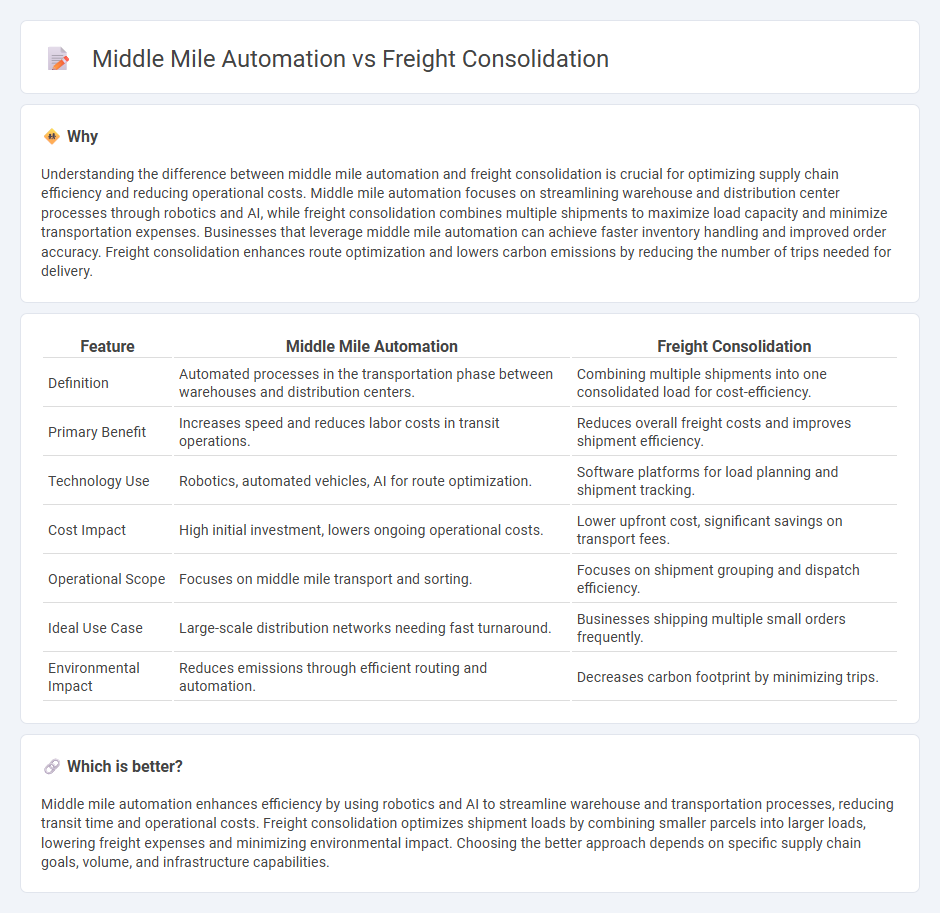
Middle mile automation enhances supply chain efficiency by utilizing robotics, AI, and IoT to streamline warehouse operations and transportation management. Freight consolidation optimizes shipping costs and reduces carbon emissions by combining multiple shipments into a single load, improving overall logistics sustainability. Explore how integrating middle mile automation with freight consolidation can revolutionize your logistics strategy.
Why it is important
Understanding the difference between middle mile automation and freight consolidation is crucial for optimizing supply chain efficiency and reducing operational costs. Middle mile automation focuses on streamlining warehouse and distribution center processes through robotics and AI, while freight consolidation combines multiple shipments to maximize load capacity and minimize transportation expenses. Businesses that leverage middle mile automation can achieve faster inventory handling and improved order accuracy. Freight consolidation enhances route optimization and lowers carbon emissions by reducing the number of trips needed for delivery.
Comparison Table
| Feature | Middle Mile Automation | Freight Consolidation |
|---|---|---|
| Definition | Automated processes in the transportation phase between warehouses and distribution centers. | Combining multiple shipments into one consolidated load for cost-efficiency. |
| Primary Benefit | Increases speed and reduces labor costs in transit operations. | Reduces overall freight costs and improves shipment efficiency. |
| Technology Use | Robotics, automated vehicles, AI for route optimization. | Software platforms for load planning and shipment tracking. |
| Cost Impact | High initial investment, lowers ongoing operational costs. | Lower upfront cost, significant savings on transport fees. |
| Operational Scope | Focuses on middle mile transport and sorting. | Focuses on shipment grouping and dispatch efficiency. |
| Ideal Use Case | Large-scale distribution networks needing fast turnaround. | Businesses shipping multiple small orders frequently. |
| Environmental Impact | Reduces emissions through efficient routing and automation. | Decreases carbon footprint by minimizing trips. |
Which is better?
Middle mile automation enhances efficiency by using robotics and AI to streamline warehouse and transportation processes, reducing transit time and operational costs. Freight consolidation optimizes shipment loads by combining smaller parcels into larger loads, lowering freight expenses and minimizing environmental impact. Choosing the better approach depends on specific supply chain goals, volume, and infrastructure capabilities.
Connection
Middle mile automation enhances efficiency by streamlining warehouse operations and transportation scheduling, directly impacting freight consolidation processes. Automated systems enable precise load optimization and timely shipment grouping, reducing empty miles and transportation costs. Freight consolidation benefits from real-time data and automated tracking, improving delivery speed and reducing environmental impact across the supply chain.
Key Terms
**Freight Consolidation:**
Freight consolidation optimizes supply chain efficiency by combining multiple smaller shipments into a single larger shipment, reducing transportation costs and minimizing carbon emissions. This method enhances warehouse space utilization and improves delivery reliability by decreasing the number of individual shipments. Explore how freight consolidation can streamline your logistics and boost operational savings.
Load Optimization
Freight consolidation improves load optimization by combining multiple smaller shipments into a single, larger shipment, reducing transportation costs and minimizing empty space in trailers. Middle mile automation leverages technology like IoT sensors and AI-driven route planning to maximize load efficiency and streamline handling during transit. Discover how combining these strategies can enhance supply chain performance and cost savings.
Carrier Coordination
Freight consolidation enhances carrier coordination by combining multiple shipments into one load, optimizing route planning and reducing transportation costs. Middle mile automation utilizes technology to streamline carrier communication, automate scheduling, and track shipments in real-time, improving operational efficiency. Explore deeper insights to understand how these strategies can transform your logistics management.
Source and External Links
Understanding Freight Consolidation - SupplierWiki - Freight consolidation is the process of combining many dispersed shipments into a single freight container to reduce shipping costs and increase efficiency, often involving multiple suppliers shipping smaller quantities to a consolidation center where goods are grouped and transported together.
What is Freight Consolidation? Trinity Explains. - Freight consolidation is combining multiple small shipments within a region into a single load hauled by a carrier to a destination region, enabling shippers to save on costs, optimize logistics, and pay bulk rates by shipping freight all at once instead of individually.
Freight Consolidation: What It Is and When to use it. - Freight consolidation boosts profitability by allowing shipments to qualify for full truckload pricing at less-than-truckload volumes, improving supply chain performance by reducing handling and delays, and providing faster and more reliable deliveries through fewer touchpoints.
 dowidth.com
dowidth.com